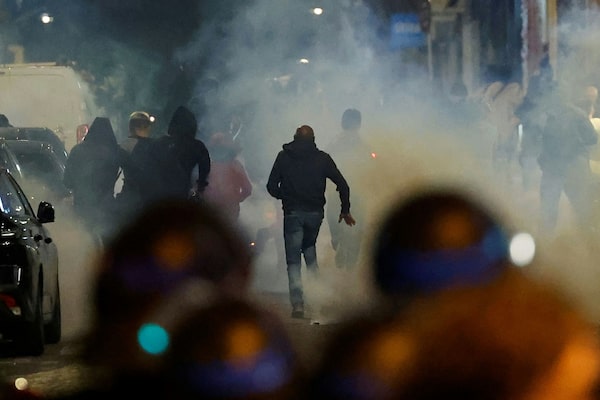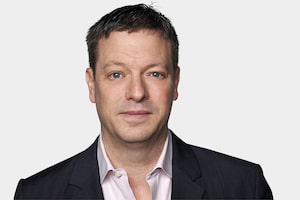
Demonstrators run as French police officers use tear gas in Paris on July 2, five days after a 17-year-old was killed by police in Nanterre, a western suburb.LUDOVIC MARIN/AFP/Getty Images
It’s a recurring pattern: Police do something awful to a young man from a community that’s already subject to aggressive policing. Their denials are shattered when a video appears; its undeniable horrors provoke an explosion of violent rioting and purposeless destruction that spreads across the city and then across the country, lasting days and sometimes weeks.
It’s what happened in cities across the United States in 2020, following the murder of George Floyd. It’s what happened in England in 2011, when the shooting of a young Black man, Mark Duggan, set cities aflame for days.
But when it happens in France, as it did with extraordinary intensity over the past week, it plays out in a different register. The rioting and looting is more destructive, the rioters seemingly younger and less political or organized, the police response far more hardcore and vengeful – and the political reaction, both in Paris and abroad, is inevitably hyperbolic and prone to declarations of existential doom.
It took only days after police in the Paris suburb of Nanterres shot to death 17-year-old Nahel Merzouk over routine traffic violations before the resulting rioting and criminality was described by right-wing politicians as “pending civil war” or “the death of France.”
The fact that most rioters were French teenagers of Arab or African ethnicity living in the notorious apartment suburbs led to some politicians blaming the violence on “radical Islam” or immigration. In fact, police said 90 per cent of those arrested were children of French citizens, who had an average age of 17 and reportedly had little to say about religion or politics – they are clearly troubled and disconnected, but their violence was almost motiveless.
It wasn’t significantly different in character from the flaming riots that tore across France earlier this year over protests against President Emmanuel Macron raising the pension age to 64, or the extensive destruction and brutal police reprisals that accompanied the 2018-20 protests of the right-wing Yellow Vests against taxes and environmental policies. Those, however, were mostly white people.
This past Tuesday, at the peak of this latest terror – that is, just as the riots were abating – the historian Georges Bensoussan spoke in a widely reprinted front-page interview in Le Figaro of the “Palestinization” and “archipelization” of France, in which he claims “the process of anomie, which destabilizes our societies, has cleared the field for barbarians who aspire to enormous power.” The national police union officially described the teens as “savage hordes” and “pests.”
As was the case with past riots, great efforts were expended last week in blaming the teenaged rioters’ parents – which most often means mothers (hardly any rioters were reportedly over 25, and a shocking number were 12 or 13). President Emmanuel Macron joined in, declaring that “on the first offence, we should be able to financially and easily penalize the families of delinquents – a sort of minimum tariff from the first act of insanity.” It’s hard to imagine how this would improve things.
Like the riots of 2005, which were also triggered by the deaths of brown-skinned teenagers being pursued by police and resulted in weeks of violence and thousands of cars being burned, there is a reflex desire to search for a root cause. I was in France during those riots and their aftermath, and there were two popular explanations.
On the left, they were described as an act of political resistance by an economically excluded population living in racially segregated human warehouses. On the right, they were described as the manifestation of an atavistic African culture that could not be integrated into French nationhood.
Neither explanation bore much resemblance to the reality of the riots. But policy responses drew from both explanations. Tens of billions were spent making the apartment suburbs more connected, well-serviced and economically viable (though dwarfed by the sums spent recently making the already very walkable wealthy centre of Paris even more walkable). That work remains incomplete; Mr. Macron ditched most of those initiatives in 2018.
But huge amounts were also spent making the policing more militaristic, less community-based and armed with weapons banned elsewhere in Europe; the low-income suburbs are now often policed through periodic commando-style raids from outside. Shahin Vallée, a former adviser to Mr. Macron, this week described “France’s runaway police force” as “a hotbed of racism and brutality” in need of root-to-branch reform.
Few seem to understand that the rioters of 2005 are not the same people or families as those of 2023. If the apartment suburbs are prisons or places of non-integration, a great many, probably a majority, managed to escape and become integrated into French or European, society. It’s the broken and troubled who remain, with few opportunities and increasingly inhuman treatment from outside. It shouldn’t surprise us that their sons return the favour.
 Doug Saunders
Doug Saunders